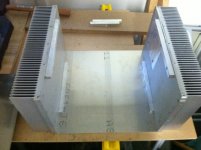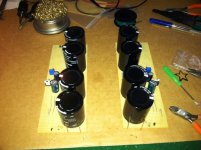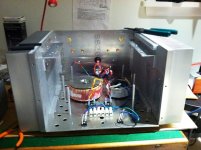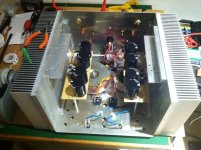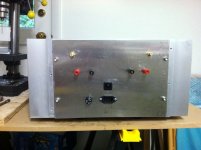@1000Volts
See "SIT Nemesis" by Nelson Pass.
i have tried changing a 0,22uf coupling cap ( Vcap tft) with a good interstage transfo ( lundhal) and always prefer the Cap in my SE tube amp ( 26 / AD1)
perhaps with a 10000uf output cap replacement it will be another story 🙂
Hi
Anyone interested in Arcol 250 Watts Thick Film Power resistors @ 13 Ohms 5% tolerance
I am about to order but the minimum amount is 10 pieces
Therfore I will have 8 surplus at £20 each plus shipping payment by paypal gift.
Cheers
Rob
Anyone interested in Arcol 250 Watts Thick Film Power resistors @ 13 Ohms 5% tolerance
I am about to order but the minimum amount is 10 pieces
Therfore I will have 8 surplus at £20 each plus shipping payment by paypal gift.
Cheers
Rob
Be sure to observe the temp derating chart and supply an ample heatsink. These (if I have the right ones) are rated at 100% of their resistance at 50C and 70% or so at 100C.
If, for example, you intend to run them at higher temperature you need to choose the resistance value accordingly. Or, make sure you use a heatsink that keeps them around 50C while dissipating 75 Watts or so.
I have seen a few cases where thick film resistors are being used on anemic heat sinks where they are probably only providing half the intended resistance.
If, for example, you intend to run them at higher temperature you need to choose the resistance value accordingly. Or, make sure you use a heatsink that keeps them around 50C while dissipating 75 Watts or so.
I have seen a few cases where thick film resistors are being used on anemic heat sinks where they are probably only providing half the intended resistance.
Scratch the above. The chart in the datasheet is a power derating chart. You still need to be mindful of the power derating of course and remember you're dissipating 75 Watts or so, i.e. similar logic applies.
Last edited:
Especially be mindfull of thick film and power Rs. They are not forgiving. You F$%^ them up with over temp and they are done! I like the 50W, 25W etc. Dale and Mills etc. They are 50ppm and 1%. You can over power them on occassion but you can servive it ussually. Allthough, I have seen the big plastic resistor go shooting right outta that heat sink a few times...
Personally, I always spec a pwr R at at least 5 times the neceessary pwr and I like 50ppm devices here. Just my 2Cents 😀
Personally, I always spec a pwr R at at least 5 times the neceessary pwr and I like 50ppm devices here. Just my 2Cents 😀
I'm with Lee, I like to overbuild too. I'd be tempted to spread that out over a couple of resistors if I could.
The lightbulbs have certain advantages, cost being one.
The lightbulbs have certain advantages, cost being one.
I'll also mention at this juncture, that I believe many of the differences heard in various drain loads are probably in greater part due to differences in operating point rather than the specific materials involved, which is not to say they have no effect, but I would put greater emphasis on finding the most satisfying operating point first.
I'll also mention at this juncture, that I believe many of the differences heard in various drain loads are probably in greater part due to differences in operating point rather than the specific materials involved, which is not to say they have no effect, but I would put greater emphasis on finding the most satisfying operating point first.
Hi Mike yep I agree ,I'm happy with my sweetspot Vds now hence now looking at the resistors and 13ohm is the value I require.
Mmmm not a bad idea going parallel with a pair of 26ohm....
Here is the spec
http://www.arcolresistors.com/wp-content/uploads/2012/04/FPA250-8-12.141.pdf
Last edited:
Within my chosen operating range of 18-20 Vds and 1.5-1.9 A, I noticed significant differences in what I would term 'balance' as I increased B+ to around 100v with a 45ohm load.
Bearing in mind that the speaker load is in parallel with the drain load, the differences could be in large part due to the effect of this interaction. The improved power output could also have an impact.
As I mentioned in an earlier post, I would have happily settled for this configuration had Michael not introduced the inductor loading alternative. The Hammond 193 inductor loading achieves a somewhat similar 'balance' but sounds a little 'ponderous' in my opinion.
I ultimately settled on the Hammond alternative for the following reasons :
1. Not having to figure out the heatsinking required to dissipate almost 200w per channel.
2. The need for power supply components for 100v B+ supply.
3. The need for 100v rated output coupling capacitors.
4. Not having to deal with turn-on 'thump'.
I have to admit that the design choices I ultimately settled on were as much influenced by practicalities as sonic considerations and I still harbor some regret in not pursuing the resistor load design. I have since moved on (or back) to tubes and as good and unique as the SIT amp is, it has not moved me away from tubes.
Bearing in mind that the speaker load is in parallel with the drain load, the differences could be in large part due to the effect of this interaction. The improved power output could also have an impact.
As I mentioned in an earlier post, I would have happily settled for this configuration had Michael not introduced the inductor loading alternative. The Hammond 193 inductor loading achieves a somewhat similar 'balance' but sounds a little 'ponderous' in my opinion.
I ultimately settled on the Hammond alternative for the following reasons :
1. Not having to figure out the heatsinking required to dissipate almost 200w per channel.
2. The need for power supply components for 100v B+ supply.
3. The need for 100v rated output coupling capacitors.
4. Not having to deal with turn-on 'thump'.
I have to admit that the design choices I ultimately settled on were as much influenced by practicalities as sonic considerations and I still harbor some regret in not pursuing the resistor load design. I have since moved on (or back) to tubes and as good and unique as the SIT amp is, it has not moved me away from tubes.
I tried higher B+ and higer drain loads early-on (see the 2SK82 + Lightbulbs thread) I settled in elsewhere because I liked the dimmer glow-factor and I didn't have any 100V caps. How's that for scientific?
I tried higher B+ and higer drain loads early-on (see the 2SK82 + Lightbulbs thread) I settled in elsewhere because I liked the dimmer glow-factor and I didn't have any 100V caps. How's that for scientific?
I did try 64 volt VDD with a 500w(220Volt) light bulb. Vdrain at around 18 , and I did like it . But I will try also a light bulb of 700w for a little more current .
s
Still playing 🙂
resistors changed to some Audio Note Tants with pleasing results and some analogue meters fitted to measure Id and Vds with the bias pot finally on the front making it soo much easier to find that sweet spot

resistors changed to some Audio Note Tants with pleasing results and some analogue meters fitted to measure Id and Vds with the bias pot finally on the front making it soo much easier to find that sweet spot

Last edited:
Thanks Gents not you Zen Mod,how dare you ......they're gorgeous 😀
Seriously though ,once I'm happy with the bits underneath I'll box it up and make it look sexy,thinking copper top plate with a nice wood surround.
Seriously though ,once I'm happy with the bits underneath I'll box it up and make it look sexy,thinking copper top plate with a nice wood surround.
Hey guys, I don't know if you've seen this new article from Papa.
http://www.firstwatt.com/pdf/art_sit_nemesis.pdf
Anyway, it has some really interesting news. "Also I have reason to believe that we will see some new SIT parts from a couple of sources in the coming year – parts that you should be able to actually buy.
You should probably start saving for them now..."
http://www.firstwatt.com/pdf/art_sit_nemesis.pdf
Anyway, it has some really interesting news. "Also I have reason to believe that we will see some new SIT parts from a couple of sources in the coming year – parts that you should be able to actually buy.
You should probably start saving for them now..."
Hey guys, I don't know if you've seen this new article from Papa.
http://www.firstwatt.com/pdf/art_sit_nemesis.pdf
Anyway, it has some really interesting news. "Also I have reason to believe that we will see some new SIT parts from a couple of sources in the coming year – parts that you should be able to actually buy.
You should probably start saving for them now..."
mmmm how nice ! 🙂
Some SIT Pics
Here's my take on the CCS SIT amp. It's almost complete. Was going to name it MR SITA for Mike Rothacher Static Induction Transistor Amp. 😉
Hope you approve! 😀
Here's my take on the CCS SIT amp. It's almost complete. Was going to name it MR SITA for Mike Rothacher Static Induction Transistor Amp. 😉
Hope you approve! 😀
Attachments
- Home
- Amplifiers
- Pass Labs
- L'Amp: A simple SIT Amp


